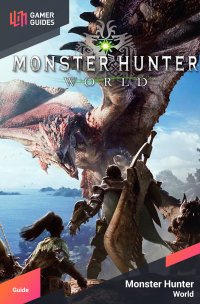Hunting High Rank Monsters¶
Aside from a few quests regarding the Pukei-Pukei (which should have unlocked after you killed the high rank Pukei-Pukei), there’s probably not much in the way of new quests you can embark on to chase after these high rank monsters. To unlock such quests, you’ll need to research the monsters out in the wild, and to do that you’ll have to go on expeditions. You can travel to previously-explored areas the same way you went on normal expeditions, just make sure you have “High Rank” expeditions selected. When you leave Astera and are able to select your destination, you’ll be able to toggle between Low Rank and High Rank expeditions by pressing [L1] and [R1] or [LB] and [RB].
High Rank expeditions are similar to normal ones in many respects. The maps are the same, and monster populations are very similar, for the most part. As the Pukei-Pukei showed, however, you may encounter some critters outside of their normal range, and it’s worth keeping in mind that almost all monsters in high rank expeditions will be stronger versions… even small monsters like Jagras and Kestodons. There may also be new resource nodes scattered about, like red-crystal mineral deposits. Bonepiles and mineral deposits will now have a chance to yield new, high-end materials, as will most of the monsters you fight, so it’s worth killing and looting as you search for large monsters.
Speaking of which, most large monsters now have expanded Research Levels, with the new maximum being level six. As you find tracks and build up more Research Points, you’ll gain progress to these new levels, which will add information concerning these high rank monsters into your Monster Field Guide (material drops, strengths and weaknesses, etc.). Locate a high rank monster in the wild and you should unlock at least one optional quest charging you with hunting it, but you can also challenge them in expeditions, as usual. If contact the the monster isn’t enough to unlock a quest for it, give it a go in battle. Worse case scenario, you get carted, which carries little penalty while on an expedition. Best case scenario, you kill it and get its lovely materials as well as the odd quest or investigation. Now isn’t the time for timidity!
While it’s summed up in a few sentences, the amount of work lying ahead of you is truly great. Return to all the old areas, loot old material deposits for new materials, and research and hunt the high rank versions of familiar monsters. While doing so, be on the lookout for Gajalaka Doodles and ??? Rathian tracks to advance those objectives. You also may encounter new, mysterious monsters on expeditions, so be especially keen to hunt down information on such foes. Naturally, as you hunt higher-grade monsters you’ll get higher grade materials, with which to create higher great arms and armor, which brings up the next topic concerning high rank gameplay…
High Rank Arms and Armor¶
Stop over at the Workshop and talk to the Second Fleet Master, who tells you that all the new (presumably high rank) materials has allowed him to craft even better gear, unlocking the final tier of weapons. If you want to take a gander at the maximum potential of your weapons, go give it a gander. For now, however, you should be eyeing more modest upgrades in the form of Rarity 5 weapons, some of which may be no more than a few hunts away.
While high rank weapon upgrades aren’t too complicated - just a long-awaited progression of what you’ve been doing since the beginning of the game, really - new high rank armors are a different story. Go take a gander at the armor you can create and you should notice quite a list of high rank armor available.
High rank armor comes in two forms, an alpha (α) version and a beta (β) version. While they usually have similar costs to create, the α versions have more/high skill levels, while the β versions have decoration slots, which brings up another new feature of high rank armor: decorations. More on that in a bit, for now, just note that β versions allow for greater skill customization. Since you don’t have many decorations at your disposal, stick to α versions of armor for the early parts of high rank gameplay and just mix and match your armor based on what skills they have. As you obtain more decorations and the resistances on said armor become more important, you’ll want to eventually transition into highly customized β armor, perhaps creating specific suits of armor for individual, high rank monsters.
Decorations are like charms in that they carry various skills with them, but unlike charms, they’re not stand-alone items you can equip. Instead, they can be inserted into weapons or armor, allowing you to customize your skills more precisely. Gear can have up to three decoration slots, and each slot can have a decoration of variable quality in it, as denoted by the symbol next to the “Slots” line in the item’s description. Decorations and their corresponding slots range from level 1 to 3, and while you can equip a lower level decoration in a high level slot, you can’t equip a high level decoration in a low level slot. For example, a level 2 decoration can’t be inserted into a level 1 slot, but a level 1 decoration could be fitted into a level 2 slot. You can add and remove decorations from gear, so there’s no real excuse to keep them in reserve.
With that information in mind, it’s time to get started with various expeditions, bounties, delivery requests and optional quests… the latter of which will have to be unlocked by doing some of the former options. This is a rather open-ended bit of gameplay, but it’ll be covered in the next section by painting with broad strokes and giving generalized information and advice.

 Sign up
Sign up

No Comments